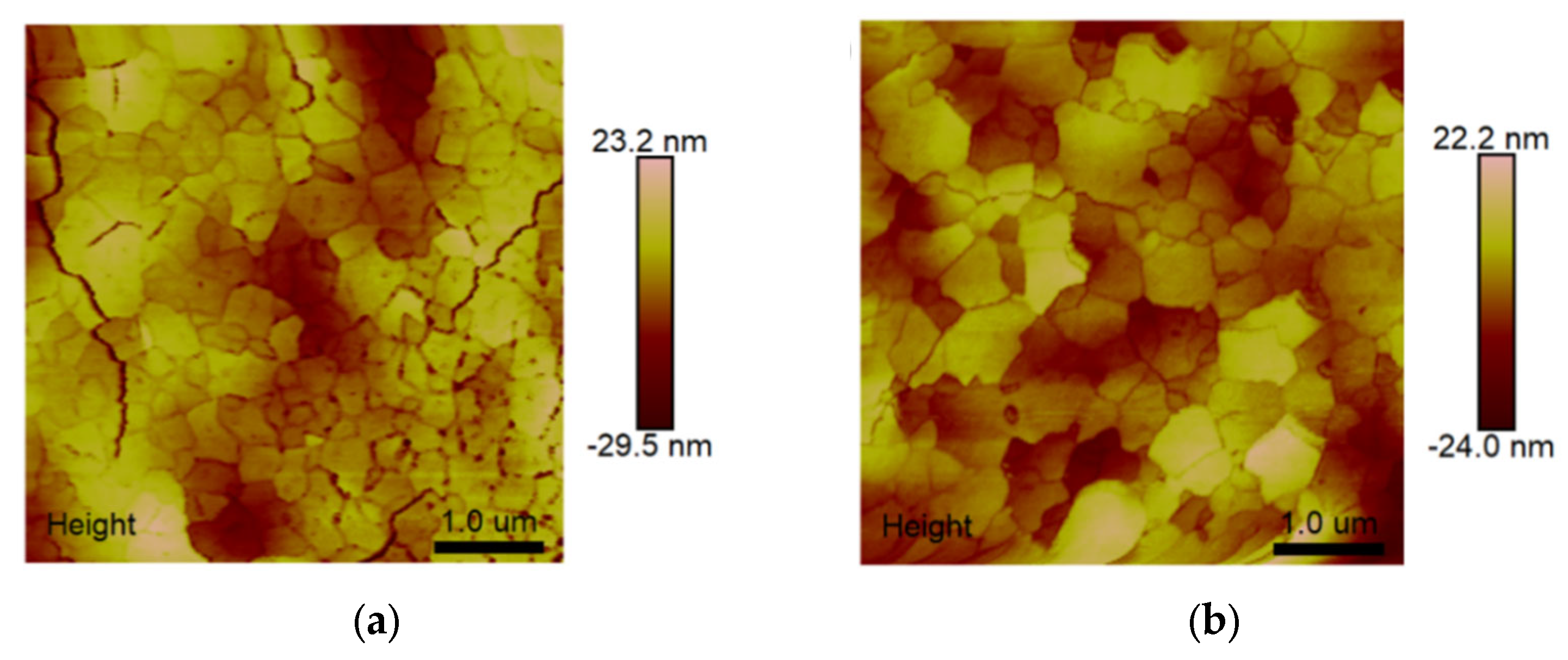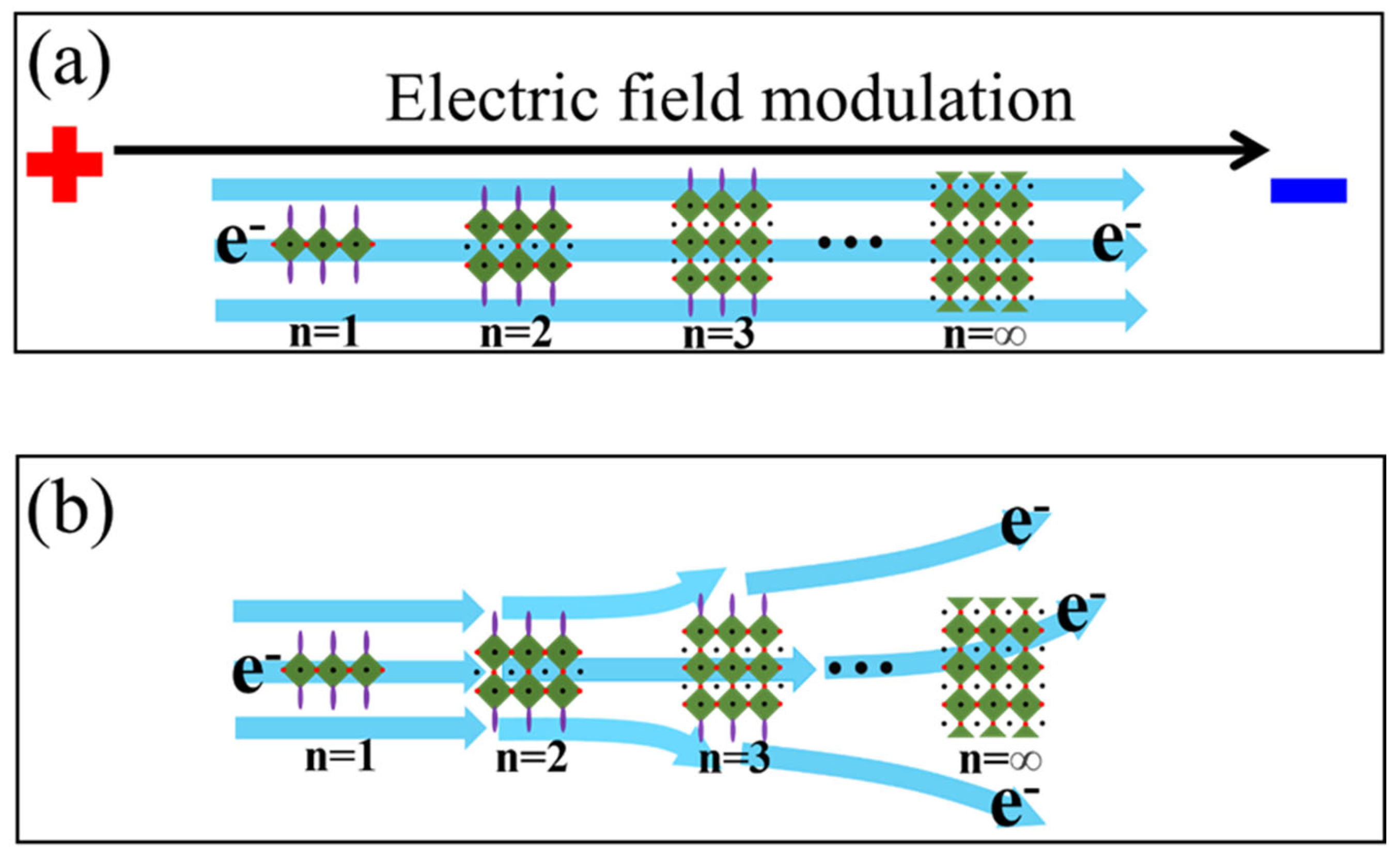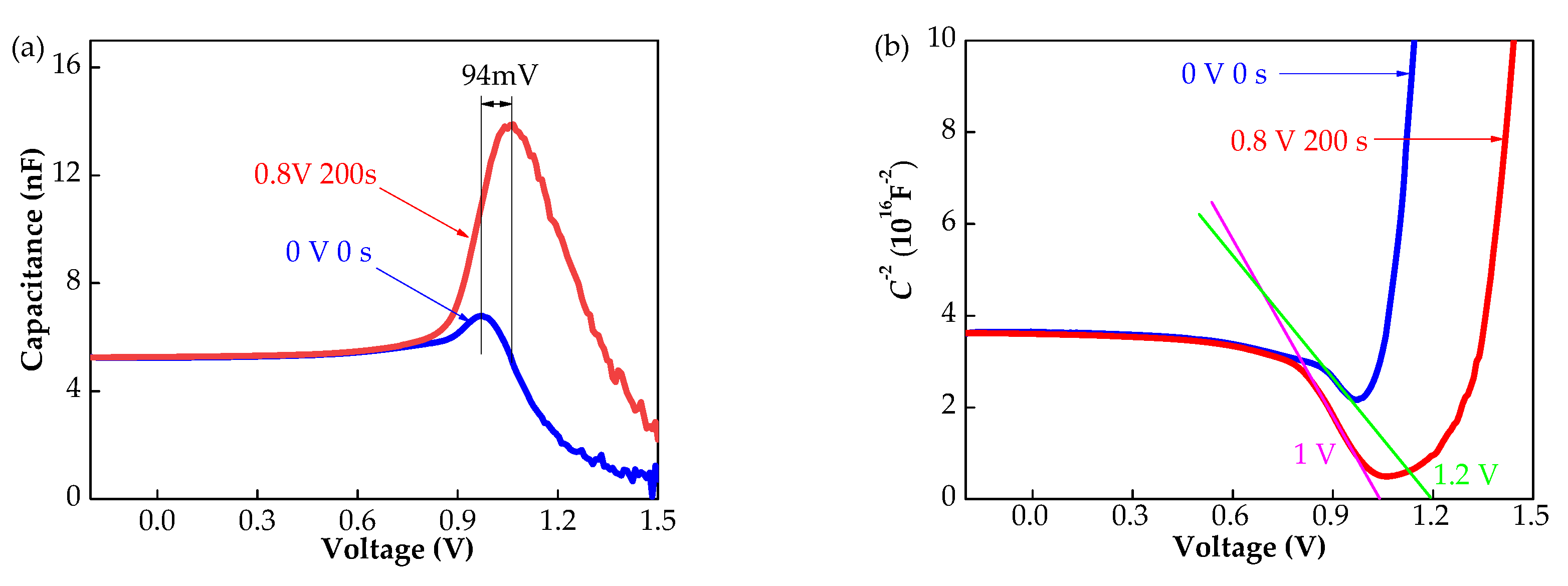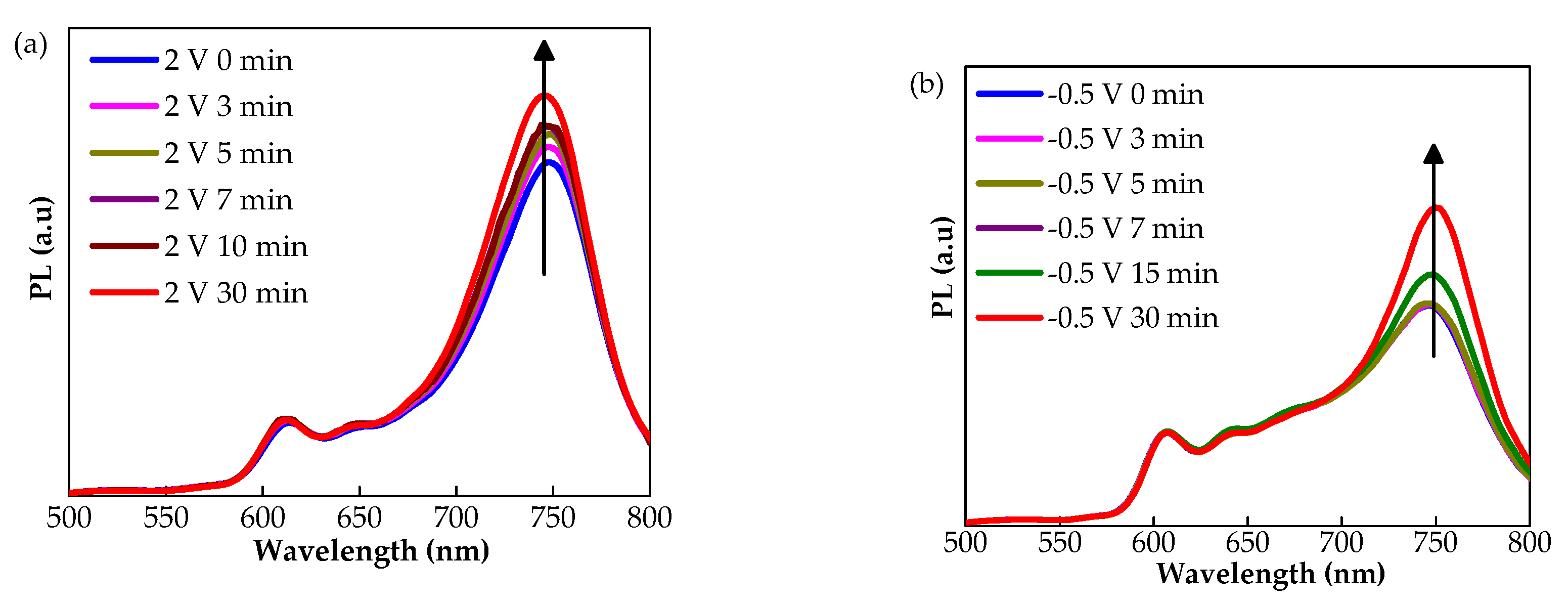Formation of a Fast Charge Transfer Channel in Quasi-2D Perovskite Solar Cells through External Electric Field Modulation
Abstract
:1. Introduction
2. Materials and Methods
2.1. Material Processing and Device Fabrication
2.2. Device Characterization
3. Results
3.1. Device Section
3.2. AFM Methodology
3.3. Signal Analysis (Electric Field Modulation and Impedance Spectra Analysis)
4. Discussion
5. Conclusions
Supplementary Materials
Author Contributions
Funding
Institutional Review Board Statement
Informed Consent Statement
Data Availability Statement
Acknowledgments
Conflicts of Interest
References
- Lee, J.-W.; Dai, Z.; Han, T.-H.; Choi, C.; Chang, S.-Y.; Lee, S.-J.; De Marco, N.; Zhao, H.; Sun, P.; Huang, Y.; et al. 2D perovskite stabilized phase-pure formamidinium perovskite solar cells. Nat. Commun. 2018, 9, 3021. [Google Scholar] [CrossRef] [Green Version]
- Ma, C.; Shen, D.; Ng, T.-W.; Lo, M.-F.; Lee, C.-S. 2D Perovskites with short interlayer distance for high-performance solar cell application. Adv. Mater. 2018, 30, e1800710. [Google Scholar] [CrossRef]
- Cohen, B.-E.; Wierzbowska, M.; Etgar, L. High efficiency and high open circuit voltage in quasi 2D perovskite based solar cells. Adv. Funct. Mater. 2016, 27, 1604733. [Google Scholar] [CrossRef]
- Yang, W.S.; Park, B.-W.; Jung, E.H.; Jeon, N.J.; Kim, Y.C.; Lee, D.U.; Shin, S.S.; Seo, J.; Kim, E.K.; Noh, J.H.; et al. Iodide management in formamidinium-lead-halide–based perovskite layers for efficient solar cells. Science 2017, 356, 1376–1379. [Google Scholar] [CrossRef] [Green Version]
- Ren, M.; Cao, S.; Zhao, J.; Zou, B.; Zeng, R. Advances and challenges in two-dimensional organic–inorganic hybrid per-ovskites toward high-performance light-emitting diodes. Nano Micro Lett. 2021, 13, 1–36. [Google Scholar] [CrossRef] [PubMed]
- Liu, P.; Yu, S.; Xiao, S. Research progress on two-dimensional (2D) halide organic–inorganic hybrid perovskites. Sustain. Energy Fuels 2021, 5, 3950–3978. [Google Scholar] [CrossRef]
- Zhang, L.; Sun, C.; He, T.; Jiang, Y.; Wei, J.; Huang, Y.; Yuan, M. High-performance quasi-2D perovskite light-emitting diodes: From materials to devices. Light Sci. Appl. 2021, 10, 61. [Google Scholar] [CrossRef] [PubMed]
- Zhang, X.; Munir, R.; Xu, Z.; Liu, Y.; Tsai, H.; Nie, W.; Li, J.; Niu, T.; Smilgies, D.; Kanatzidis, M.G.; et al. Phase Transition Control for High Performance Ruddlesden–Popper Perovskite Solar Cells. Adv. Mater. 2018, 30, e1707166. [Google Scholar] [CrossRef] [PubMed] [Green Version]
- Roghabadi, F.A.; Alidaei, M.; Mousavi, S.M.; Ashjari, T.; Tehrani, A.S.; Ahmadi, V.; Sadrameli, S.M. Stability progress of perovskite solar cells dependent on the crystalline structure: From 3D ABX3 to 2D Ruddlesden–Popper perovskite absorbers. J. Mater. Chem. A 2019, 7, 5898–5933. [Google Scholar] [CrossRef]
- Wang, K.; Li, Z.; Zhou, F.; Wang, H.; Bian, H.; Zhang, H.; Wang, Q.; Jin, Z.; Ding, L.; Liu, S. Ruddlesden–Popper 2D Com-ponent to Stabilize γ-CsPbI3 Perovskite Phase for Stable and Efficient Photovoltaics. Adv. Energy Mater. 2019, 9, 1902529. [Google Scholar] [CrossRef]
- Chen, Y.; Sun, Y.; Peng, J.; Tang, J.; Zheng, K.; Liang, Z. 2D Ruddlesden-Popper Perovskites for Optoelectronics. Adv. Mater. 2018, 30, 1703487. [Google Scholar] [CrossRef] [PubMed]
- Zheng, K.; Chen, Y.; Sun, Y.; Chen, J.; Chábera, P.; Schaller, R.; Al-Marri, M.J.; Canton, S.E.; Liang, Z.; Pullerits, T. Inter-phase charge and energy transfer in Ruddlesden–Popper 2D perovskites: Critical role of the spacing cations. J. Mater. Chem. A 2018, 6, 6244–6250. [Google Scholar] [CrossRef]
- Tsai, H.; Nie, W.; Blancon, J.-C.; Stoumpos, C.; Asadpour, R.; Harutyunyan, B.; Neukirch, A.J.; Verduzco, R.; Crochet, J.; Tretiak, S.; et al. High-efficiency two-dimensional Ruddlesden–Popper perovskite solar cells. Nat. Cell Biol. 2016, 536, 312–316. [Google Scholar] [CrossRef]
- Zhang, J.; Qin, J.; Wang, M.; Bai, Y.; Zou, H.; Keum, J.K.; Tao, R.; Xu, H.; Yu, H.; Haacke, S.; et al. Uniform Permutation of Quasi-2D perovskites by vacuum poling for efficient, high-fill-factor solar cells. Joule 2019, 3, 3061–3071. [Google Scholar] [CrossRef]
- Xiao, X.; Dai, J.; Fang, Y.; Zhao, J.; Zheng, X.; Tang, S.; Rudd, P.N.; Zeng, X.C.; Huang, J. Suppressed Ion Migration along the In-Plane Direction in Layered Perovskites. ACS Energy Lett. 2018, 3, 684–688. [Google Scholar] [CrossRef]
- Kim, H.; Kim, J.S.; Heo, J.-M.; Pei, M.; Park, I.-H.; Liu, Z.; Yun, H.J.; Park, M.-H.; Jeong, S.-H.; Kim, Y.-H. Proton-transfer-induced 3D/2D hybrid perovskites suppress ion migration and reduce luminance overshoot. Nat. Commun. 2020, 11, 3378. [Google Scholar] [CrossRef]
- Lin, Y.; Bai, Y.; Fang, Y.; Wang, Q.; Deng, Y.; Huang, J. Suppressed ion migration in low-dimensional perovskites. ACS Energy Lett. 2017, 2, 1571–1572. [Google Scholar] [CrossRef]
- Liu, P.; Wang, W.; Liu, S.; Yang, H.; Shao, Z. Fundamental understanding of photocurrent hysteresis in perovskite solar cells. Adv. Energy Mater. 2019, 9, 1803017. [Google Scholar] [CrossRef]
- Cheng, T.; Tumen-Ulzii, G.; Klotz, D.; Watanabe, S.; Matsushima, T.; Adachi, C. Ion migration-induced degradation and efficiency roll-off in quasi-2D perovskite light-emitting diodes. ACS Appl. Mater. Interfaces 2020, 12, 33004–33013. [Google Scholar] [CrossRef] [PubMed]
- Liu, F.; Wang, L.; Wang, J.; Wang, F.; Chen, Y.; Zhang, S.; Sun, H.; Liu, J.; Wang, G.; Hu, Y. 2D Ruddlesden–popper perovskite single crystal field-effect transistors. Adv. Funct. Mater. 2021, 31, 2005662. [Google Scholar] [CrossRef]
- Li, Z.; Xiao, C.; Yang, Y.; Harvey, S.P.; Kim, D.H.; Christians, J.A.; Yang, M.; Schulz, P.; Nanayakkara, S.U.; Jiang, C.-S.; et al. Extrinsic ion migration in perovskite solar cells. Energy Environ. Sci. 2017, 10, 1234–1242. [Google Scholar] [CrossRef]
- Zhang, J.; Chen, R.; Wu, Y.; Shang, M.-H.; Zeng, Z.; Zhu, Y.; Han, L. Extrinsic Movable Ions in MAPbI3 Modulate Energy Band Alignment in Perovskite Solar Cells. Adv. Energy Mater. 2017, 8, 1701981. [Google Scholar] [CrossRef]
- Leijtens, T.; Kandada, A.R.S.; Eperon, G.E.; Grancini, G.; D’Innocenzo, V.; Ball, J.M.; Stranks, S.D.; Snaith, H.J.; Petrozza, A. Modulating the electron–Hole interaction in a hybrid lead halide perovskite with an electric field. J. Am. Chem. Soc. 2015, 137, 15451–15459. [Google Scholar] [CrossRef]
- Hu, X.; Wang, X.; Fan, P.; Li, Y.; Zhang, X.; Liu, Q.; Zheng, W.; Xu, G.; Wang, X.; Zhu, X.; et al. Visualizing Carrier Transport in Metal Halide Perovskite Nanoplates via Electric Field Modulated Photoluminescence Imaging. Nano Lett. 2018, 18, 3024–3031. [Google Scholar] [CrossRef] [PubMed]
- Shi, J.; Xu, X.; Zhang, H.; Luo, Y.; Li, D.; Meng, Q. Intrinsic slow charge response in the perovskite solar cells: Electron and ion transport. Appl. Phys. Lett. 2015, 107, 163901. [Google Scholar] [CrossRef]
- Zhang, J.; Zhu, X.; Wang, M.; Hu, B. Establishing charge-transfer excitons in 2D perovskite heterostructures. Nat. Commun. 2020, 11, 2618. [Google Scholar] [CrossRef] [PubMed]
- Wu, G.; Li, X.; Zhou, J.; Zhang, J.; Zhang, X.; Leng, X.; Wang, P.; Chen, M.; Zhang, D.; Zhao, K.; et al. Fine Multi-Phase Alignments in 2D Perovskite Solar Cells with Efficiency over 17% via Slow Post-Annealing. Adv. Mater. 2019, 31, e1903889. [Google Scholar] [CrossRef] [PubMed]
- Eames, C.; Frost, J.M.; Barnes, P.; O’Regan, B.C.; Walsh, A.; Islam, M.S. Ionic transport in hybrid lead iodide perovskite solar cells. Nat. Commun. 2015, 6, 7497. [Google Scholar] [CrossRef] [Green Version]
- De Bastiani, M.; Dell’Erba, G.; Gandini, M.; D’Innocenzo, V.; Neutzner, S.; Kandada, A.R.S.; Grancini, G.; Binda, M.; Prato, M.; Ball, J.M. Ion migration and the role of preconditioning cycles in the stabilization of the J–V characteristics of inverted hybrid perovskite solar cells. Adv. Energy Mater. 2016, 6, 1501453. [Google Scholar] [CrossRef]
- Hoke, E.T.; Slotcavage, D.J.; Dohner, E.R.; Bowring, A.R.; Karunadasa, H.I.; McGehee, M.D. Reversible photo-induced trap formation in mixed-halide hybrid perovskites for photovoltaics. Chem. Sci. 2015, 6, 613–617. [Google Scholar] [CrossRef] [Green Version]
- Fabregat-Santiago, F.; Garcia-Belmonte, G.; Mora-Seró, I.; Bisquert, J. Characterization of nanostructured hybrid and organic solar cells by impedance spectroscopy. Phys. Chem. Chem. Phys. 2011, 13, 9083–9118. [Google Scholar] [CrossRef]
- Zhu, X.; Wang, K.; Zhao, F.; Han, C.; Yang, Q.; Yu, H.; Zhang, F.; Hu, B. Revisiting the Impact of Interfacial Transport Layers on Organic Bulk Heterojunction Systems. ACS Appl. Energy Mater. 2018, 1, 3457–3468. [Google Scholar] [CrossRef]
- Lin, Y.; Fang, Y.; Zhao, J.; Shao, Y.; Stuard, S.J.; Nahid, M.M.; Ade, H.; Wang, Q.; Shield, J.E.; Zhou, N. Unveiling the operation mechanism of layered perovskite solar cells. Nat. Commun. 2019, 10, 1008. [Google Scholar] [CrossRef] [PubMed]
- Zhu, X.; Xu, H.; Liu, Y.; Zhang, J.; Wang, M.; Ivanov, I.N.; Ovchinnikova, O.S.; Hu, B. Two-Photon Up-conversion photo-luminescence realized through spatially extended gap states in Quasi-2D perovskite films. Adv. Mater. 2019, 31, 1901240. [Google Scholar] [CrossRef] [PubMed]








| Modulation Bias | VOC (V) | JSC (mA·cm−2) | FF (%) | PCE (%) |
|---|---|---|---|---|
| 0 V | 1.03 | 20.14 | 63.89 | 13.2 |
| 0.8 V | 1.04 | 20.28 | 63.69 | 13.45 |
| 1.0 V | 1.04 | 20.06 | 63.57 | 13.27 |
| 1.5 V | 1.10 | 19.22 | 59.03 | 12.48 |
| −0.1 V | 1.10 | 18.11 | 63.00 | 12.55 |
| −0.5 V | 0.87 | 18.48 | 32.97 | 5.27 |
| Modulation Bias | Time (Second) | VOC (V) | JSC (mA·cm−2) | FF (%) | PCE (%) |
|---|---|---|---|---|---|
| 0 V | 0 s | 1.03 | 20.14 | 63.89 | 13.20 |
| 2 V | 200 s | 1.10 | 18.82 | 59.89 | 12.40 |
| 230 s | 1.06 | 18.30 | 62.51 | 12.07 | |
| 380 s | 1.04 | 18.52 | 62.06 | 12.00 | |
| 500 s | 1.04 | 18.82 | 62.26 | 12.20 |
| Modulation Bias | Restore Time | VOC (V) | JSC (mA·cm−2) | FF (%) | PCE (%) |
|---|---|---|---|---|---|
| 2 V | 20 s | 1.12 | 17.7 | 62.25 | 12.34 |
| 0 | 24 h | 1.06 | 20.37 | 63.77 | 13.75 |
Publisher’s Note: MDPI stays neutral with regard to jurisdictional claims in published maps and institutional affiliations. |
© 2021 by the authors. Licensee MDPI, Basel, Switzerland. This article is an open access article distributed under the terms and conditions of the Creative Commons Attribution (CC BY) license (https://creativecommons.org/licenses/by/4.0/).
Share and Cite
Zhu, X.; Peng, L.; Li, J.; Yu, H.; Xie, Y. Formation of a Fast Charge Transfer Channel in Quasi-2D Perovskite Solar Cells through External Electric Field Modulation. Energies 2021, 14, 7402. https://doi.org/10.3390/en14217402
Zhu X, Peng L, Li J, Yu H, Xie Y. Formation of a Fast Charge Transfer Channel in Quasi-2D Perovskite Solar Cells through External Electric Field Modulation. Energies. 2021; 14(21):7402. https://doi.org/10.3390/en14217402
Chicago/Turabian StyleZhu, Xixiang, Liping Peng, Jinpeng Li, Haomiao Yu, and Yulin Xie. 2021. "Formation of a Fast Charge Transfer Channel in Quasi-2D Perovskite Solar Cells through External Electric Field Modulation" Energies 14, no. 21: 7402. https://doi.org/10.3390/en14217402
APA StyleZhu, X., Peng, L., Li, J., Yu, H., & Xie, Y. (2021). Formation of a Fast Charge Transfer Channel in Quasi-2D Perovskite Solar Cells through External Electric Field Modulation. Energies, 14(21), 7402. https://doi.org/10.3390/en14217402







